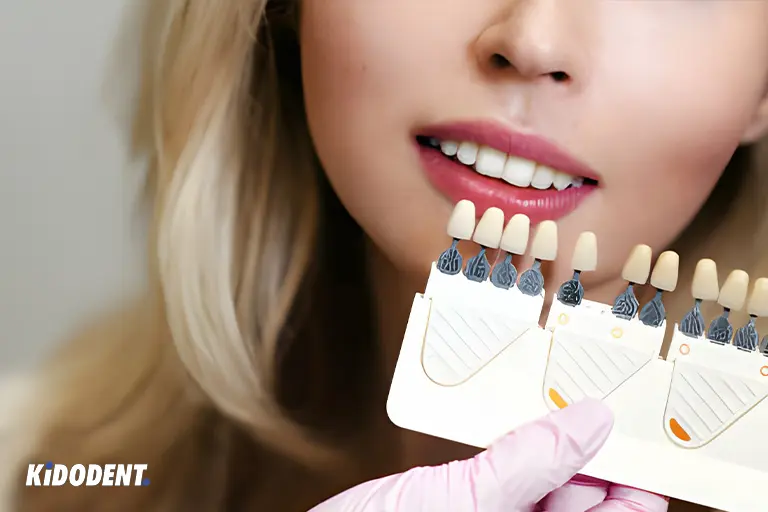What are veneers?
Dental veneers are tooth-colored thin shells that are bonded to the surface of your teeth, which cover any unattractive, chipped, or discolored teeth. They are a popular way for masking stained and crooked teeth and a great option to hide teeth gaps and correct less severe tooth irregularities. If you have been looking for a stable cosmetic procedure to transform your smile with attractive pearly white teeth, with no doubt veneers can do that for you.
What are the benefits of veneers?
Veneers are the most popular cosmetic dental procedures that can bring you fresh and white teeth with a much younger smile on your face. They are custom-made and offer you an enhanced smile, which you may want to show off. Dental veneers can catch any eye and doesn’t matter which type you choose (porcelain or composite veneers), you will be a happier and more confident person after you see the changes in your teeth.
Veneers can treat and do multiple dental problems that you have problems with:
- Provide you with attractive white and bright teeth
- Enhance your smile by treating lip line and changes to your teeth
- Offer great treatment for chipped and mild fractured teeth
- Lengthen your short teeth
- Correct and cover the gap between the teeth and other spaces in your teeth like diastema
- Mask your stained and discolored teeth when teeth whitening procedure can’t remove the stains
- Cover the mild protrusion and crookedness in your teeth
What are the different types of veneers?
Porcelain veneers
Porcelain or ceramic veneers are the main type of veneers that are tooth-shaped shells that fit over teeth. They are made in the laboratory and dentists use special adhesive or bonding agents to bond them to your teeth. Porcelain is the most beautiful material that is used in cosmetic dentistry. Because of its biocompatible properties, porcelain makes a healthy cosmetic material for your teeth.
Pros
- durable and long-lasting
- retains the polished surface and are abrasion-resistance
- better color and shade matching to your teeth because they are made in the lab
- stain-resistance and wear-resistance
- the most natural-looking cosmetic look for teeth, which look great even after many years
Cons
- More expensive
- take more time to make (2 to 3 appointments)
- used mostly for front teeth.
- Need much dental work and enamel removal
- harder to fix
Composite veneers
Composite veneers are a dental treatment option to cover your teeth using composite material. Here your dentist uses composite resin dental bonding to mask your teeth. The material is prepared before and directly applied to tooth or teeth that you want to cover. Composite veneers take one dental visit and is the quickest way to have your teeth veneered.
Pros
- Less expensive and affordable
- Less enamel removal
- Take 1 single visit
- Easier to fix
- The quickest way to get white and beautiful teeth
Cons
- Doesn’t last longer as porcelain veneers
- Risks of breakage especially if not done by a professional dentist
- Can get stained
How are veneers attached to your teeth?
Porcelain veneers procedure step-by-step
- Your dentist will take an impression of the teeth to get a mold of your teeth (impression stage). They use high-tech imaging with laser to scan your mouth to get your veneer size that fits your teeth.
- The mold is sent to the lab to have your custom-made veneers ready.
- Once made, you will need another visit to prepare your teeth (tooth preparation stage). Your dentist carves out the tooth enamel slightly.
- Your dentist bonds the porcelain veneers on your teeth (bonding stage). Dentists use special resin and adhesives to fix them in place.
- After placement, your dentist contours and polishes any rough edges that may bother your gums. You will need to visit the dentist one week later to have your final finishing process done. Because you may need more contouring, cutting, or polishing, and this makes your veneers as comfortable as possible.
Composite veneers procedure step-by-step
- Your dentist roughens and carves the enamel on the surface of your teeth called the acid etching technique.
- Composite material is applied on your tooth’s surface.
- Your dentist shapes the composite and uses special light (light-curing) to heat and bond the material to your teeth.
- Finally, the dentist uses dental polishing techniques to contour and polish the edges and give you a shiny look.
How much do veneers cost?
The average cost of veneers ranges from $800 to $2,000 per tooth. And you will need more budget for multiple teeth procedures. The price depends on the type, location of teeth you want, and other factors like the location of the clinic and having a well-trained dentist to do the job.
Caring tips after your veneers
- Avoid brushing your teeth with abrasive harsh toothbrushes or toothpaste.
- Brush your teeth twice a day and floss regularly.
- Do not chew on ice or other rough things.
- Avoid biting your fingernails and other bad dental habits like teeth clenching.
- Use splint or bite appliance (occlusal guard appliance) to protect your veneers if you have bruxism or extreme irregularities like overbite or underbite problems.
